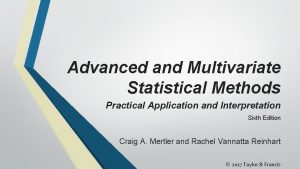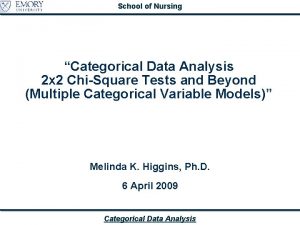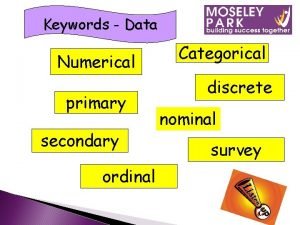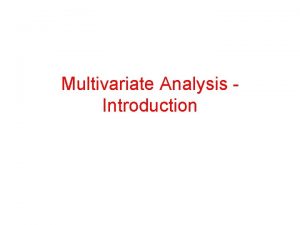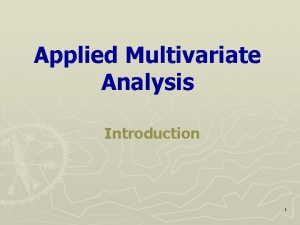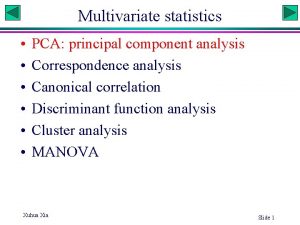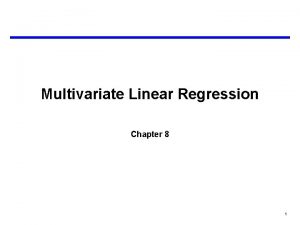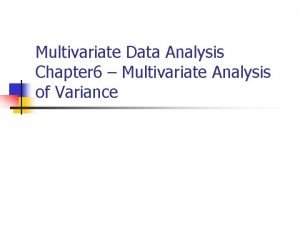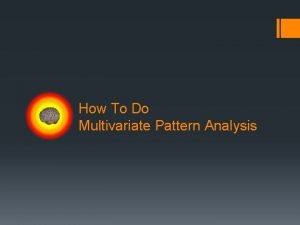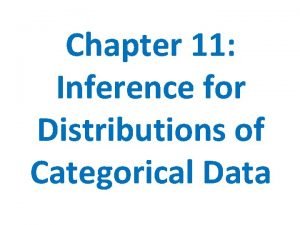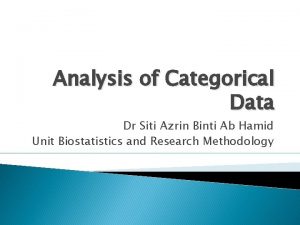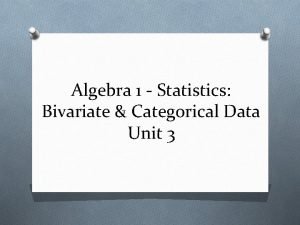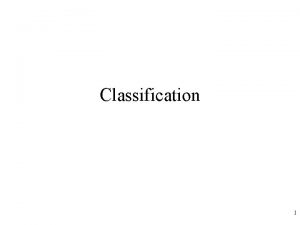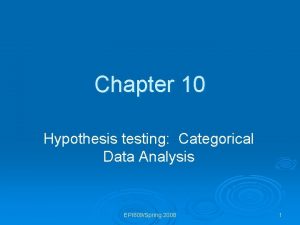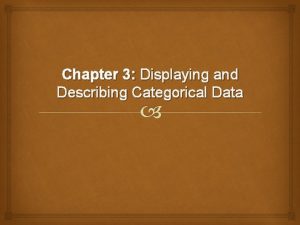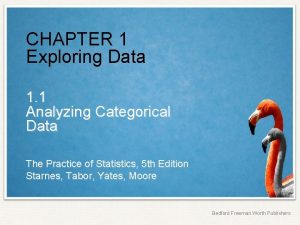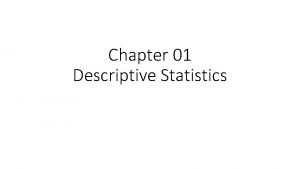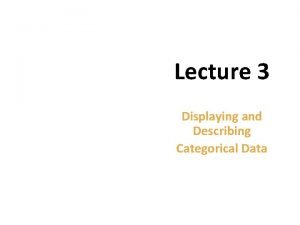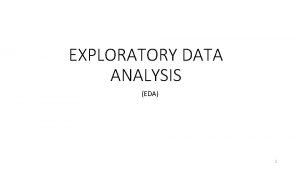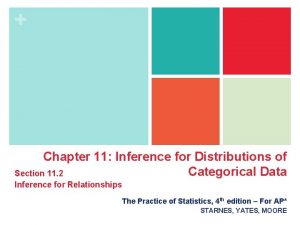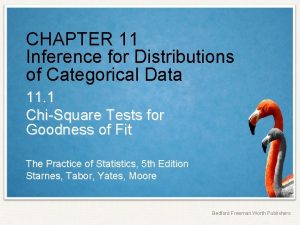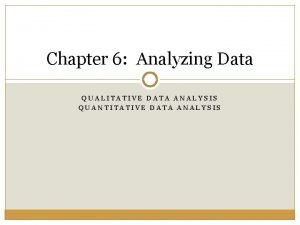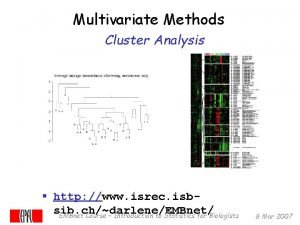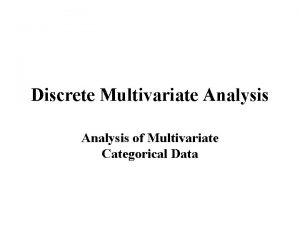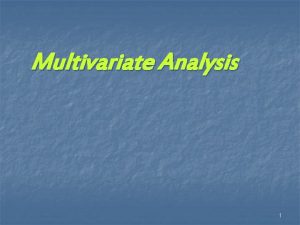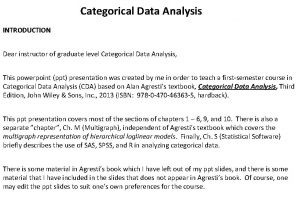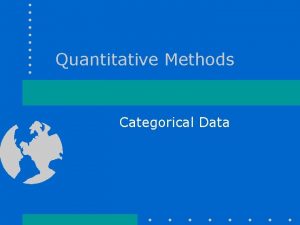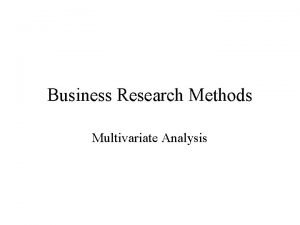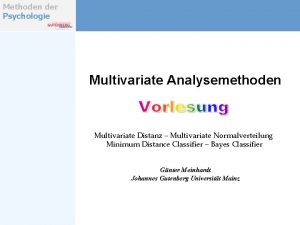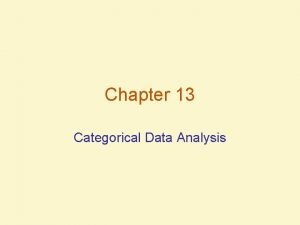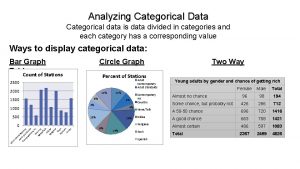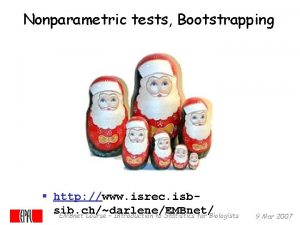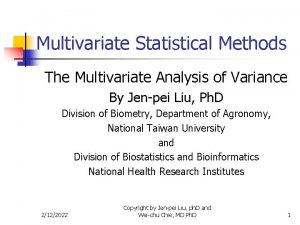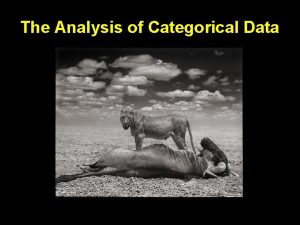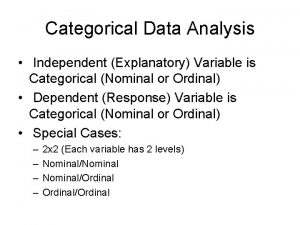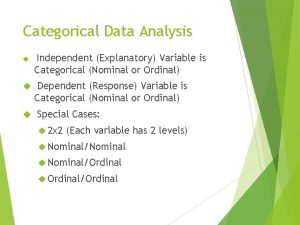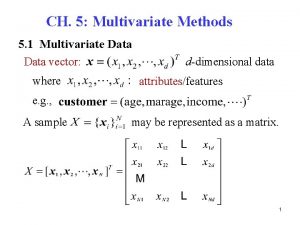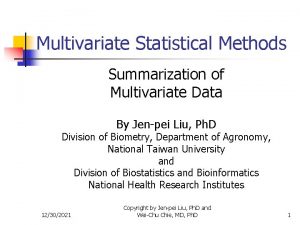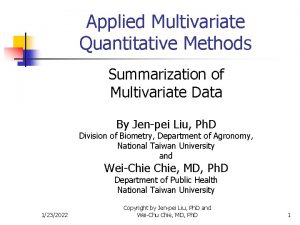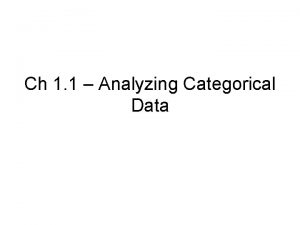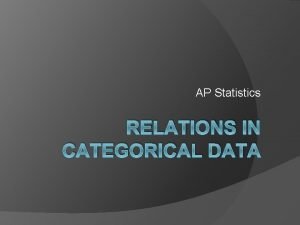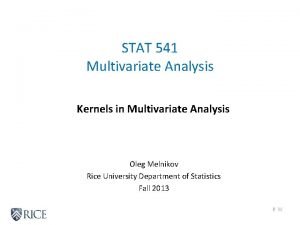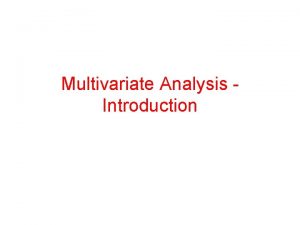Multivariate Methods Categorical Data Analysis http www isrec





























- Slides: 29

Multivariate Methods Categorical Data Analysis § http: //www. isrec. isbsib. ch/~darlene/EMBnet/ EMBnet Course – Introduction to Statistics for Biologists 8 Mar 2007

Variables (review) § Statisticians call characteristics which can differ across individuals variables § Types of variables: – Numerical • Discrete – possible values can differ only by fixed amounts (most commonly counting values) • Continuous – can take on any value within a range (e. g. any positive value) – Categorical • Nominal – the categories have names, but no ordering (e. g. eye color) • Ordinal – categories have an ordering (e. g. `Always’, `Sometimes’, ‘Never’) Lec 4 b EMBnet Course – Introduction to Statistics for Biologists 8 Mar 2007

Categorical data analysis § A categorical variable can be considered as a classification of observations § Single classification – goodness of fit § Multiple classifications – contingency table – homogeneity of proportions – independence Lec 4 b EMBnet Course – Introduction to Statistics for Biologists 8 Mar 2007

Mendel and peas § Mendel’s experiments with peas suggested to him that seed color (as well as other traits he examined) was caused by two different ‘gene alleles’ (he didn’t use this terminology back then!) § Each (non-sex) cell had two alleles, and these determined seed color: y/y, y/g, g/y g/g Lec 4 b EMBnet Course – Introduction to Statistics for Biologists 8 Mar 2007

Peas, cont § Here, yellow is dominant over green § Sex cells each carry one allele § Also postulated that the gene pair of a new seed determined by combination of pollen and ovule, which are passed on independently pollen parent seed parent y g yy ¼ Lec 4 b y yg ¼ gy ¼ g gg ¼ EMBnet Course – Introduction to Statistics for Biologists 8 Mar 2007

Did Mendel’s data prove theory? § We know today that he was right, but how good was his experimental proof? § The statistician R. A. Fisher claimed the data fit theory too well : ‘the general level of agreement beween Mendel’s expectations and his reported results shows that it is closer than would be expected in the best of several thousand repetitions. . I have no doubt that Mendel was deceived by a gardening assistant, who know only too well what his principal expected from each trial made’ § How can we measure how well data fit a prediction? Lec 4 b EMBnet Course – Introduction to Statistics for Biologists 8 Mar 2007

Testing for goodness of fit § The NULL is that the data were generated according to a particular chance model § The model should be fully specified (including parameter values); if parameter values are not specified, they may be estimated from the data § The TS is the chi-square statistic : 2 = sum of [(observed – expected)2 / expected] § The 2 distribution depends on a number of degrees of freedom Lec 4 b EMBnet Course – Introduction to Statistics for Biologists 8 Mar 2007

Example § A manager takes a random sample of 100 sick days and finds that 26 of the sick days were taken by the 20 -29 age group, 37 by 30 -39, 24 by 40 -49, and 13 by 50 and over § These groups make up 30%, 40%, 20%, and 10% of the labor force at the company. Test the hypothesis that age is not a factor in taking sick days. . . Lec 4 b EMBnet Course – Introduction to Statistics for Biologists 8 Mar 2007

Example, contd Age Observed Expected Difference 2 20 -29 26 . 3*100=30 26 -30=-4 (-4)2/30 30 -39 37 40 -49 24 50 13 =. 533 (total=100) § 2 =. 533 + _____ 2. 46 § To get the p-value in R: > pchisq(2. 46, 3, lower. tail=FALSE) Lec 4 b EMBnet Course – Introduction to Statistics for Biologists 8 Mar 2007

Multiple variables: rxc contingency tables § A contingency table represents all combinations of variable levels for the different classifications § r = number of rows, c = number of columns § Example: – Hair color = Blond, Red, Brown, Black – Eye color = Blue, Green, Brown § Numbers in table represent counts of the number of cases in each combination (‘cell ’) § Row and column totals are called marginal counts Lec 4 b EMBnet Course – Introduction to Statistics for Biologists 8 Mar 2007

cells Hair/eye table Eye Blue Hair Green Brown Blond n 11 n 12 n 13 n 1. Red n 21 n 22 n 23 n 2. Brown n 31 n 32 n 33 n 3. Black n 41 n 42 n 43 n 4. n. 1 n. 2 n. 3 column margins Lec 4 b row margins Grand Total n. . EMBnet Course – Introduction to Statistics for Biologists 8 Mar 2007

Hair/eye table for our class Eye Blue Hair Green Brown Blond Red Brown Black Lec 4 b EMBnet Course – Introduction to Statistics for Biologists 8 Mar 2007

Special Case: 2 x 2 tables § Each variable has 2 levels § Measures of association – Odds ratio (cross-product) ad/bc – Relative risk [ a/(a+b) / (c/(c+d)) ] + Total group 1 a (n 11) b (n 12) n 1. group 2 c (n 21) d (n 22) Total Lec 4 b n. 1 n. 2 n 2. n. . EMBnet Course – Introduction to Statistics for Biologists 8 Mar 2007

Chi-square Test of Independence § Tests association between two categorical variables – NULL: The 2 variables (classifications) are independent § Compare observed and expected frequencies among the cells in a contingency table § The TS is the chi-square statistic : 2 = sum of [(observed – expected)2 / expected] § df = (r-1) (c-1) – So for a 2 x 2 table, there is 1 df Lec 4 b EMBnet Course – Introduction to Statistics for Biologists 8 Mar 2007

Chi-square independence test: intuition § Construct bivariate table as it would look under the NULL, ie if there were no association § Compare the real table to this hypothetical one § Measure how different these are § If there are sufficiently large differences, we conclude that there is a significant relationship § Otherwise, we conclude that our numbers vary just due to chance Lec 4 b EMBnet Course – Introduction to Statistics for Biologists 8 Mar 2007

Expected frequencies § How do we find the expected frequencies? § Under the NULL hypothesis of independence, the chance of landing in any cell should be the product of the relevant marginal probabilities § ie, expected number nij = N*[(ni. /N) * (n. j/N)] = ni. *n. j/N Lec 4 b EMBnet Course – Introduction to Statistics for Biologists 8 Mar 2007

Are hair and eye color independent? § Let’s see… Lec 4 b EMBnet Course – Introduction to Statistics for Biologists 8 Mar 2007

Chi-Square test assumptions § Data are a simple random sample from some population § Data must be raw frequencies (not percentages) § Categories for each variable must be mutually exclusive (and exhaustive) § The chi-square test is based on a large sample approximation, so the expected numbers should not be too small (at least 5 in most cells) Lec 4 b EMBnet Course – Introduction to Statistics for Biologists 8 Mar 2007

Another Example § Quality of sleep before elective operation… Lec 4 b Bad OK Total trt 2 17 19 Placebo 8 15 23 Total 10 32 42 EMBnet Course – Introduction to Statistics for Biologists 8 Mar 2007

A lady tasting tea § Exact test developed for the following setup: § A lady claims to be able to tell whether the tea or the milk is poured first § 8 cups, 4 of which are tea first and 4 are milk first (and the lady knows this) § Thus, the margins are known in advance § Want to assess the chance of observing a result (table) as or more extreme Lec 4 b EMBnet Course – Introduction to Statistics for Biologists 8 Mar 2007

Fisher’s Exact Test § Method of testing for association when some expected values are small § Measures the chances we would see differences of this magnitude or larger if there were no association § The test is conditional on both margins – both the row and column totals are considered to be fixed Lec 4 b EMBnet Course – Introduction to Statistics for Biologists 8 Mar 2007

More about Fisher's exact test § Fisher's exact test computes the probability, given the observed marginal frequencies, of obtaining exactly the frequencies observed any configuration more extreme § ‘More extreme ’ means any configuration with a smaller probability of occurrence in the same direction (one-tailed) or in both directions (two-tailed) Lec 4 b EMBnet Course – Introduction to Statistics for Biologists 8 Mar 2007

Example Lec 4 b + - A 2 3 5 B 6 4 10 8 7 15 EMBnet Course – Introduction to Statistics for Biologists 8 Mar 2007

Example + - A 2 3 5 B 6 4 10 8 7 15 + A 0 B 8 - + A 1 - 7 5 B Lec 4 b 8 5 10 15 7 10 15 + - A 3 5 B 10 8 7 + 4 - 8 7 + A 5 B 8 - A B 7 EMBnet Course – Introduction to Statistics for Biologists 15 5 10 15 8 Mar 2007

Example + - A 2 3 5 B 6 4 10 8 7 15 . 007 + A 0 B 8 - + A 1 - 7 5 10 15 5 - A 3 5 B 10 8 7 + 4 - 8 7 + A 5 B 8 - A B . 392 15 5 10. 163 15 7 5. 019 10 15 EMBnet Course – Introduction to Statistics for Biologists 8 Mar 2007 . 093 Lec 4 b . 326 + B 8 7 10 15

Where do these probabilities come from? ? § With both margins fixed, there is only 1 cell that can vary § The probabilities come from the hypergeometric distribution § This distribution gives probabilities for the number of ‘successes’ in a sample of size n drawn without replacement from a population of size N comprised of a known number of ‘successes’ § Chocolates… Lec 4 b EMBnet Course – Introduction to Statistics for Biologists 8 Mar 2007

Fisher’s exact test in R § In R, use the command > fisher. test() § Let’s try the Fisher test on the earlier data… Lec 4 b EMBnet Course – Introduction to Statistics for Biologists 8 Mar 2007

Problems with Fisher’s test 1. The exact test was developed for the case of fixed marginals 2. In this case the probability (p-value) computed by the Fisher test is exact (unlike the chi-square test, which relies on approximations) 3. However, this setup is unrealistic for most studies – even if we know how many samples we will get in each group, we generally cannot fix in advance both margins 4. Other methods have also been proposed to deal with this problem Lec 4 b EMBnet Course – Introduction to Statistics for Biologists 8 Mar 2007

Summary § Multivariate data analysis can be either descriptive or inferential § Methods depend on the type of variables in the data § For categorical variables, we have looked at large sample and small sample tests of association Lec 4 b EMBnet Course – Introduction to Statistics for Biologists 8 Mar 2007
 Multivariate methods in machine learning
Multivariate methods in machine learning Advanced and multivariate statistical methods
Advanced and multivariate statistical methods Categorical logic examples in nursing
Categorical logic examples in nursing Primary and secondary keywords
Primary and secondary keywords What is multivariate analysis?
What is multivariate analysis? Multi variance
Multi variance Nature of multivariate analysis
Nature of multivariate analysis Multivariate analysis of variance and covariance
Multivariate analysis of variance and covariance Multivariate analysis
Multivariate analysis Multivariate statistical analysis
Multivariate statistical analysis Multivariate analysis
Multivariate analysis Multivariate analysis
Multivariate analysis Multivariate pattern analysis
Multivariate pattern analysis Chapter 11 inference for distributions of categorical data
Chapter 11 inference for distributions of categorical data What statistical test for categorical data
What statistical test for categorical data Bivariate categorical data
Bivariate categorical data Categorical data classification
Categorical data classification H0no
H0no Chapter 3 displaying and describing categorical data
Chapter 3 displaying and describing categorical data Analyzing categorical data
Analyzing categorical data Categorical data examples
Categorical data examples Conditional relative frequency example
Conditional relative frequency example Categorical data
Categorical data Eda's
Eda's Analyzing categorical data
Analyzing categorical data Chapter 11 inference for distributions of categorical data
Chapter 11 inference for distributions of categorical data Chapter 11 inference for distributions of categorical data
Chapter 11 inference for distributions of categorical data Data analysis methods
Data analysis methods Input/output design
Input/output design Inlay wax pattern fabrication
Inlay wax pattern fabrication

